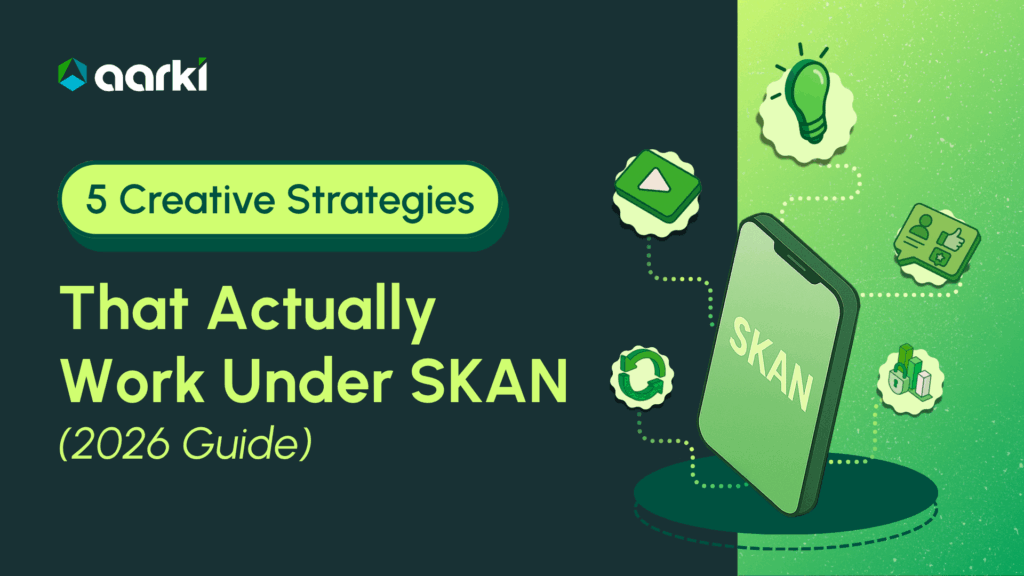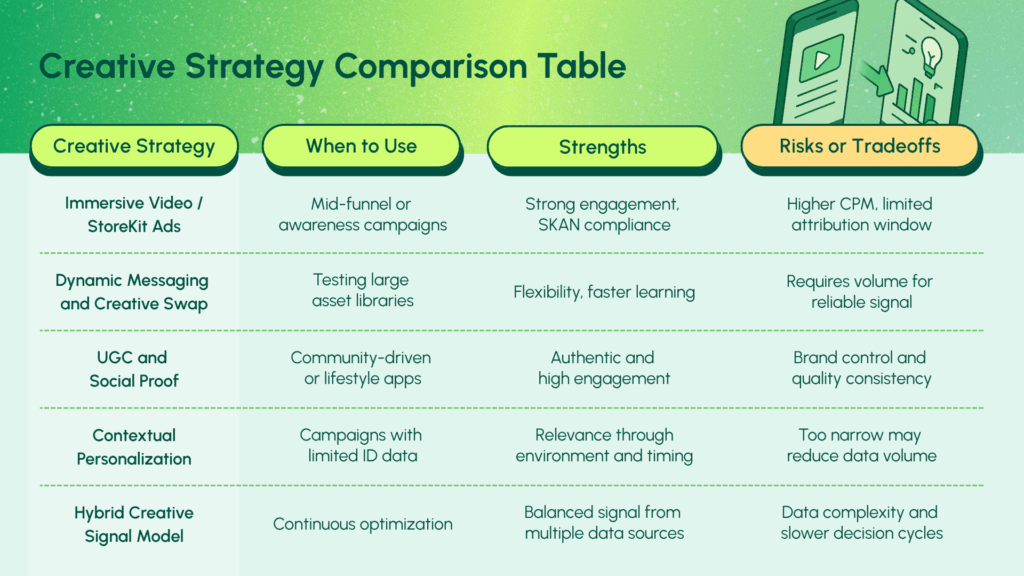
When SKAN rolled out, creative became the last lever marketers could fully control.
Targeting shrank. Measurement lagged. But the one thing still capable of moving the needle was creative that connects, converts, and complies.
In this guide, we break down five creative strategies that perform under SKAN. You will learn how they work, why they matter, and what top-performing campaigns are doing differently today.
1. Immersive Video and StoreKit Ads
Q: Can video creatives still perform under SKAN?
Yes. Video remains one of the strongest drivers of engagement on iOS, especially when you use StoreKit-rendered ads that comply directly with Apple’s framework1.
How it works:
- Use full-screen StoreKit or SKOverlay formats that open directly in the App Store without leaving the app.
- Focus the story within the first 3 seconds, since SKAN postbacks rely heavily on early actions.
- Align creative content with your key event window (for example, tutorial completion or first purchase).
Example: A mobile game promoting a new level uses a 6-second StoreKit video ad that opens directly in the App Store. Players see gameplay, then instantly install without leaving their current app. Because this ad runs through SKOverlay, it reports postbacks cleanly under SKAN and increases attributed installs by nearly 30% compared to banner placements2.
Pro tip: A/B test opening hooks. Try one emotional version and one value-driven version to see which drives more postbacks.
Related reading: How to Design a SKAN 4 Conversion Schema That Actually Works
2. Dynamic Messaging and Creative Swapping
Q: How can I adapt creative when SKAN data is limited?
Dynamic creative lets you rotate assets and automatically serve the combinations that perform best, even without real-time attribution.
How it works:
- Create modular creative templates (headline + visual + CTA).
- Allow your DSP or MMP integration to rotate versions.
- Track which asset groups drive higher aggregated performance through SKAN postbacks.
Example: A shopping app runs a SKAN campaign with three headline variants and two CTAs. The system automatically rotates all combinations until it finds that “Shop the drop” plus “Tap to preview” drives the most installs. This multi-asset testing approach helps the brand uncover winners without using user-level data3.
Pro tip: Start with high-volume campaigns first, since smaller ones may not reach Apple’s privacy thresholds for accurate results.
3. User-Generated Content (UGC) and Social Proof
Q: Does UGC still help when we can’t target users directly?
Yes. Real customer voices and creator-style ads perform strongly under SKAN because they boost engagement and help clear privacy thresholds faster.
How it works:
- Feature real testimonials, gameplay clips, or app walkthroughs.
- Use short, unpolished formats that feel authentic to social environments.
- Add overlays like “Join 10K+ users” or “See why everyone’s switching.”
Example: A subscription fitness app swaps out its polished product ads for short vertical clips filmed by real users. The content feels like organic social posts, leading to higher engagement and more SKAN postbacks within the first attribution window4.
Pro tip: Source UGC from owned channels or real customers to maintain quality and brand consistency.
Related reading: 5 Privacy-Safe Ways to Re-Engage iOS Users in 2026
4. Contextual Creative Personalization
Q: Without user-level IDs, how do I make creative feel personal?
You personalize by context, not identity.
How it works:
- Use signals such as device type, time of day, app category, or location.
- Match ad content to the environment where it appears.
- Focus messaging on user intent (“Still exploring?”, “Ready to continue your progress?”).
Example: A travel app runs one ad in the morning that says “Book your weekend escape” and another in the evening that reads “Plan tomorrow’s getaway.” Both creatives use the same assets but shift messaging based on time of day, improving engagement by 25%5.
Pro tip: Keep context broad enough to maintain scale. Too narrow a segment may lead to null postbacks under Apple’s privacy thresholds.
5. Creative Signal Testing with Hybrid Measurement
Q: How can I tell which creative actually performs under SKAN?
Blend SKAN postbacks with proxy metrics like CTR, completion rate, or engagement to create a hybrid creative signal model.
How it works:
- Collect SKAN postbacks for verified conversions.
- Track engagement metrics (CTR, video completions) for directional insight.
- Compare both in your MMP or internal analytics to find creative patterns that predict true value.
Example: A food delivery app uses SKAN postbacks for installs and completion rates from its analytics dashboard. When both metrics rise together, the team flags that creative as a “fit” and feeds it into future campaigns, improving optimization accuracy by more than 20%¹.
Pro tip: Use hybrid data to refine conversion schemas and feed learnings back into creative iteration cycles.
Related reading: SKAN vs Probabilistic vs SSOT: What’s the Difference and Why It Matters

Final Takeaways
- Build creative tests that meet minimum install volumes for meaningful signal.
- Use consistent creative naming for easier SKAN mapping.
- Rotate creative frequently to prevent fatigue.
- Feed results back into your conversion schema for smarter postback design.
- Balance production effort with measurable lift. Simpler creative often wins.
The Bottom Line
Creative still drives growth in a privacy-first world. The difference is how you test and measure it. Use immersive formats, modular designs, and contextual storytelling to unlock performance under SKAN while staying compliant with Apple’s privacy framework.
👉 Build SKAN campaigns that actually scale.
Explore how Aarki turns privacy into performance →
Citations
- Apple Developer – SKAdNetwork Overview and User Privacy Guidelines (2024) ↩︎
- Moloco – From SKAN to AdAttributionKit: Tips for iOS In-App Advertising Success (2024) ↩︎
- Moloco – SKAdNetwork Attribution Setup Guide (2024) ↩︎
- AppsFlyer – SKAN Data Learnings and Key Insights (2024) ↩︎
- Verve – User Acquisition from a Transparent Mobile DSP Perspective (2024) ↩︎